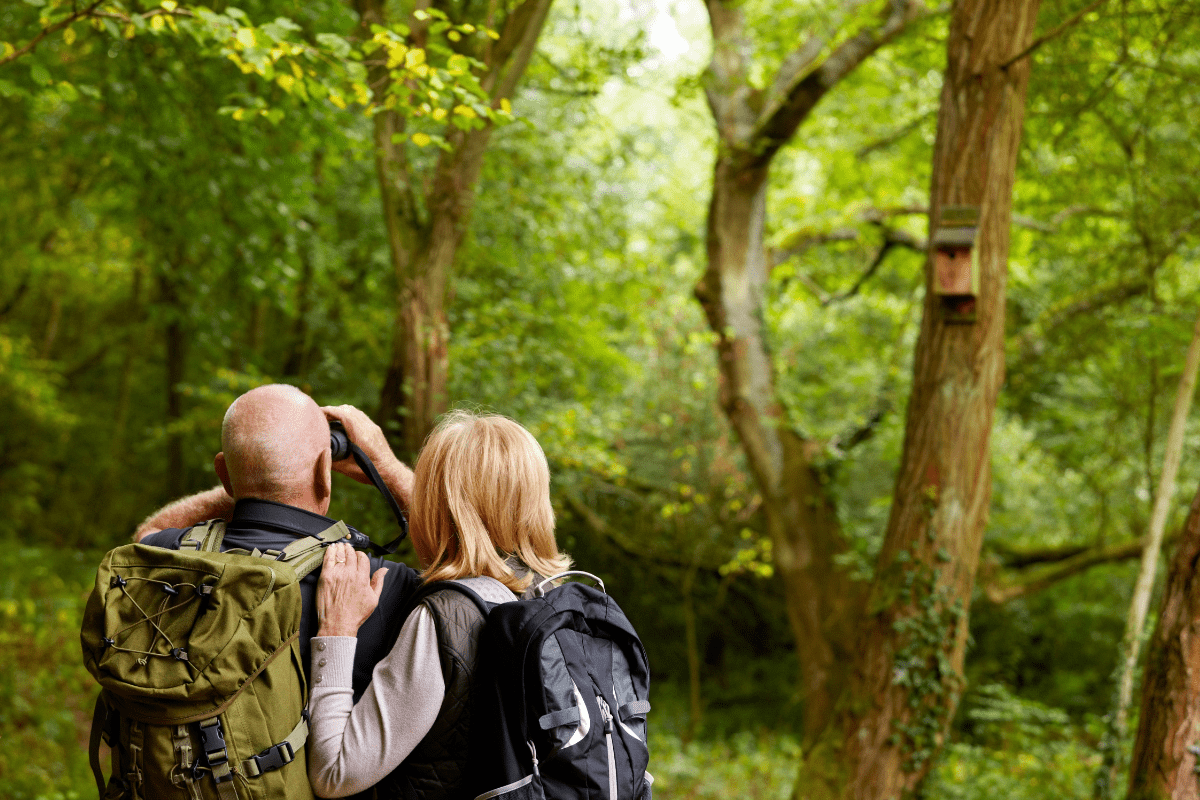Montana's wildlife viewing isn't just about getting lucky with a roadside bear sighting. It's about knowing exactly where to go, when to show up, and how to avoid becoming part of the food chain while you're snapping photos.
The unglamorous truth about wildlife safety
Before we dive into the exciting stuff about where to find grizzlies and wolves, let's talk about the thing that might save your life: bear spray. Yes, it's basically pepper spray on steroids, and yes, you absolutely need it. Think of it as your $40 insurance policy against becoming a cautionary tale at the ranger station.
Bear spray works at about 25-30 feet, which sounds like a lot until you realize how fast a grizzly can cover that distance. We're talking about 35 mph here, folks. That's faster than you ran in high school, even when you were late for first period. Practice pulling it out of the holster before you head into the backcountry. Nothing's worse than fumbling with the safety tab while a 600-pound omnivore decides whether you look tasty.
The law requires you to stay 100 yards from bears and wolves. That's the length of a football field, for those of us who need visual references. For everything else, it's 25 yards. And no, your iPhone zoom doesn't count as maintaining distance. Neither does yelling "I'm just trying to get a good shot for Instagram!"
Group hiking is your friend here. Bears generally avoid groups because we're loud, smelly, and travel in packs… kind of like teenagers at the mall. Make noise in dense areas or near streams where bears might not hear you coming. Clap, talk loudly about your favorite TV shows, or sing off-key renditions of 80s hits. Your dignity is a small price to pay for safety.
If you do encounter a bear, resist every action movie instinct you have. Don't run. I repeat: DO NOT RUN. You'll trigger their chase instinct, and remember that 35 mph thing? Instead, talk calmly in a low voice like you're trying to soothe a toddler having a meltdown in Target. Back away slowly while avoiding direct eye contact. If it's a grizzly and things go south, play dead. If it's a black bear, fight like your life depends on it, because it might.
Emergency prep that actually matters
Cell service in Montana's wilderness is about as reliable as a chocolate teapot. Satellite communicators like the Garmin inReach aren't just for paranoid preppers anymore. They're for smart people who realize that "somewhere between those two mountains" isn't a helpful location for search and rescue teams.
When to show up (hint: it's painfully early)
Here's the deal: wildlife doesn't care about your preferred sleep schedule. The best viewing happens from 30 minutes before sunrise to about an hour after. Yes, that means setting your alarm for times that start with a 4 or 5. Coffee isn't optional; it's survival equipment.
Spring: Mud season and migrating birds
March through May brings what locals affectionately call "mud season." Your rental sedan isn't going to cut it when roads turn into chocolate pudding. But if you can navigate the slop, you'll catch 300,000 snow geese at Freezeout Lake in mid-March. It's like someone dumped a snow globe full of birds into the Montana sky.
Grizzlies emerge from their dens looking hangry and heading for early vegetation in avalanche chutes. Mama bears have cubs in tow, which makes them extra protective. This is not the time to test how close you can get for that perfect shot.
Summer: Tourist season for humans and animals
June through August means all areas are accessible, but it also means competing with tour buses full of people who think wildlife viewing involves a lot of loud exclamations and camera flashes. Animals head to higher elevations to escape both the heat and the crowds. Smart creatures.
Dawn starts creeping up as early as 5 a.m., which means you'll be hitting the road while it's still dark. Pack bug spray along with your bear spray. The mosquitoes near wetlands are basically tiny vampires with wings.
Fall: Nature's grand finale
September through November is when Montana really shows off. Elk start bugling, which sounds like a broken trumpet crossed with a haunted house sound effect. Up to 500 elk gather at certain viewing areas during mating season. Bulls weighing 700 pounds get aggressive and territorial. This is not the time to wander closer for a selfie.
Bears enter what scientists call hyperphagia, which is fancy talk for "eating everything in sight." They're packing on pounds for winter, consuming up to 20,000 calories daily. That's like eating 40 Big Macs every day. They're focused but also unpredictable.
Winter: For the truly dedicated
December through February separates the casual wildlife watchers from the diehards. Temperatures can hit -20°F, which is cold enough to freeze your nose hairs instantly. But wolves are most visible against the snow, and thermal features in Yellowstone attract bison and elk looking for slightly less frigid spots.
The big three: Where everyone goes first
Let's start with the heavy hitters, the destinations that end up on everyone's bucket list for good reason.
Lamar Valley: The Serengeti of North America
Lamar Valley in Yellowstone earns its reputation as America's premier wildlife destination. You'll find 9 wolf packs totaling about 110 individuals, plus 150-200 grizzlies that call the area home. The massive bison herds look like they're straight out of a Western movie, minus the dramatic soundtrack.
Access the valley through the Northeast Entrance near Cooke City, which stays open year-round. Your $35 vehicle pass gets you seven days of wildlife watching, which sounds like a lot until you realize you'll spend half that time just waiting for animals to do something interesting.
The hot spots everyone talks about:
- Slough Creek Road for wolf watching
- Lamar Buffalo Ranch for variety pack
- Confluence of Lamar and Yellowstone rivers
- Specimen Ridge for spotting scopes
- Round Prairie for morning bison
Book your Yellowstone trip well in advance, especially if you're planning to stay in the park. The lodges fill up faster than a parking lot on Black Friday.
Many Glacier: Glacier National Park's wildlife theater
Many Glacier Valley offers what I call "amphitheater wildlife viewing." The dramatic mountain backdrop makes every animal sighting look like a National Geographic cover shot. Swiftcurrent Lake practically guarantees grizzly sightings, while Fishercap Lake hosts the moose morning show.
Here's the catch: 2025 construction means you'll need shuttle reservations from July 1 to September 21. It's like trying to get concert tickets, except instead of seeing Taylor Swift, you're hoping to spot a bear that couldn't care less about your presence.
Two Medicine Valley offers a less crowded alternative. The moose hang out near the marshy shoreline like they're at some exclusive lakeside resort. Mountain goats traverse the cliffsides with the confidence of seasoned rock climbers, while bighorn sheep graze on open slopes looking majestic and slightly judgmental.
Charles M. Russell National Wildlife Refuge: The overlooked giant
At 1.1 million acres, this refuge is huge. Like, really huge. It's the second-largest refuge in the lower 48, but most people have never heard of it. Their loss, your gain.
The 20-mile auto tour takes about 2 hours if you don't stop, but you'll stop. Trust me. With 200+ bird species and 40+ mammal species, something's always happening. The Slippery Ann Elk Viewing Area (yes, that's really its name) attracts up to 500 elk during the September-October rut. And the best part? No entrance fees. It's like finding a designer dress at a thrift store.
Hidden gems for people who hate crowds
Now for the spots that don't show up on every "Top 10 Montana Wildlife" listicle.
CSKT Bison Range: Under new management
The CSKT Bison Range near Moiese recently returned to management by the Confederated Salish and Kootenai Tribes, which feels like a correcting of cosmic balance. The 350 adult bison roaming 18,524 acres don't care about the administrative changes. They're too busy being massive and magnificent.
The 19-mile Red Sleep Drive (open May through October) winds through prairies where you'll see bison, elk, bighorn sheep, and pronghorn. Day passes run $20, which is less than you'd spend on a mediocre lunch in any gateway town. The Prairie Drive stays open year-round for those brave enough to face Montana winters.
Red Rock Lakes: Where the swans hang out
This remote refuge in the Centennial Valley served as ground zero for trumpeter swan recovery. The 53,418-acre refuge includes wilderness areas that make you feel like you've time-traveled to pre-Instagram Montana.
Getting there requires commitment. It's 28 miles from Monida on improved dirt roads, which is real estate speak for "you might need four-wheel drive after it rains." Besides swans, you'll spot moose, elk, wolves, and the occasional grizzly. Two primitive campgrounds let you stay overnight, though "primitive" means exactly what you think it means.
Freezeout Lake: The March madness
Freezeout Lake becomes absolute chaos in early March when 300,000 snow geese and 10,000 tundra swans stop by during migration. It's like someone announced free samples at Costco, but for waterfowl.
Located 40 miles west of Great Falls on Highway 89, the 12,000-acre area offers the most concentrated waterfowl viewing in Montana. Prime time runs from sunrise to 10 a.m. and again from 4:30 p.m. to sunset. The birds follow a schedule better than most airlines.
Know your neighbors: Wildlife behavior 101
Understanding animal behavior is like learning the unwritten rules of a new neighborhood. It helps you avoid awkward encounters and potentially dangerous situations.
Grizzly bears: The heavyweight champions
Grizzlies sport a distinctive shoulder hump and dished face that makes them look perpetually concerned about something. Glacier hosts about 300, while Yellowstone's ecosystem supports 150-200.
They emerge from dens in March-April looking rough, like anyone would after sleeping for months. Mothers with cubs appear in meadows during late May and early June. Come September and October, they enter pre-denning hyperphagia, basically eating everything that doesn't run away fast enough.
As of January 2025, grizzlies remain protected under the Endangered Species Act, which means harassing them for photos isn't just stupid, it's illegal.
Gray wolves: The elusive pack hunters
Montana's wolf population sits at approximately 1,091 individuals as of 2024. They're most visible in winter when snow forces their prey to lower elevations. Think of it as grocery shopping… the food moves to more convenient locations.
Wolf packs maintain territories averaging 150-200 square miles, traveling 10-20 miles daily. That's a lot of ground to cover when you're trying to spot them. Dawn and dusk howling sessions help locate packs, though success requires patience and luck. Mostly luck.
Elk: The dramatic performers
Elk turn September and October into their personal soap opera. Bulls bugle to attract mates and defend harems, creating sounds that haunt your dreams. These 700-pound animals get aggressive during rut, so maintain extra distance unless you want to star in a viral video titled "Tourist Gets Launched by Elk."
Moose: The grumpy giants
Moose prefer wetlands with abundant willows, making Glacier's valleys prime real estate. They're usually solitary, which fits their general vibe of wanting everyone to leave them alone.
Don't let their goofy appearance fool you. Moose can be surprisingly aggressive, especially mothers with calves. They're like that neighbor who seems chill until you accidentally step on their lawn.
Gear that's actually worth buying
Let's talk equipment without sounding like a late-night infomercial.
Binoculars: Your most important investment
Good binoculars change everything. The 8×42 or 10×42 models balance magnification with field of view. You could drop $2,500 on Swarovski NL Pure binoculars that make everything look like HD TV, or go with Nikon Monarch M7 for $400-500 that still make you feel fancy.
Weather-sealed construction matters when Montana decides to throw all four seasons at you in one afternoon. Rubber armor helps when you inevitably drop them while scrambling over rocks.
Camera gear for the Instagram age
Wildlife photography requires telephoto lenses starting at 400mm unless you plan on getting dangerously close. The Sony FE 200-600mm runs about $2,000 and offers versatility. The Sigma 150-600mm at $1,000-1,500 works for those of us who don't have trust funds.
Check out detailed gear reviews before dropping serious cash on equipment you'll use twice a year.
Spotting scopes: For the seriously obsessed
When binoculars aren't enough, spotting scopes pick up the slack. A 20-60x zoom with 80mm objective lens helps you count individual wolves across a valley. Mount it on a carbon fiber tripod if you enjoy not having back problems.
Making it happen: The logistics nobody talks about
The unsexy practical stuff that makes or breaks your trip.
Where to sleep (if you can find a room)
Gateway towns fill up faster than a Taylor Swift concert. West Yellowstone, Gardiner, and Whitefish offer full services but book months in advance for peak season. Smaller towns provide intimate experiences and the chance to eat at the one restaurant in town every night.
Camping extends budget options, though many campgrounds close from October to May because Montana winters don't mess around. Reserve campsites early unless you enjoy the thrill of possibly sleeping in your car.
Vehicle reality check
Your Prius isn't making it to the best wildlife spots. High-clearance 4WD vehicles open up remote refuges and forest service roads where animals haven't learned to fear humans yet. Rental availability stays limited, so reserve specialty vehicles early or prepare for disappointment.
Pack emergency kits with chains, shovel, extra fuel, food, water, and blankets. Montana's distances between services can be measured in hours, not miles. That gas station you passed 50 miles ago might be the last one you'll see today.
Professional guides: Worth considering
Guide services run $150-500 per person for full-day tours. Yes, that's real money. But they know where the animals are, have quality optics, and can identify that brown blob in the distance as either a rock or a grizzly. Photography-focused tours teach technique while keeping you at safe distances.
Montana's wildlife doesn't perform on schedule, but it rewards those who show up prepared. Start with popular spots like Lamar Valley to build confidence, then explore hidden gems as you learn the rhythms of the land. Invest in decent binoculars first, add gear gradually, and always prioritize safety over Instagram likes.
The magic happens during shoulder seasons when crowds thin out and animals get active. Book accommodations early or embrace winter's unique opportunities with proper gear and lower expectations for comfort. Whether you're watching wolves hunt in Yellowstone or catching sunrise with moose in Glacier, Montana's wildlife viewing creates stories worth telling. Just remember: the best wildlife photo is the one where everyone goes home alive and uninjured.




